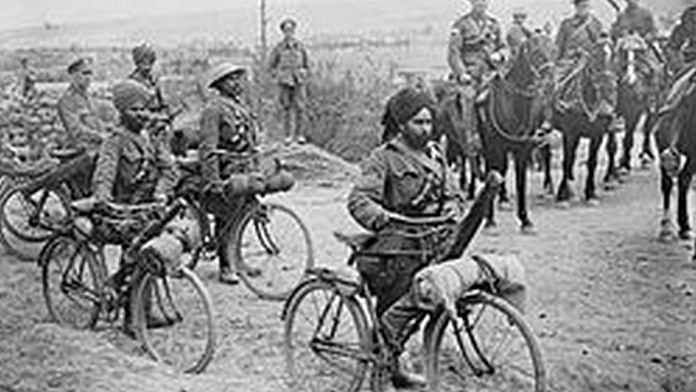By the end of World War I, an estimated 11 lakh Indians had served overseas while around 60,000 were killed.
New Delhi: The unsung Indian heroes of World War I will be the focus of commemorative initiatives as the world marks 100 years of the war’s end next month.
On 10 November, the British will gift India “War Diaries” from their archives, which are official records of units in which Indians served. The “War Diaries” would almost all be accounts of British officers.
These will include a recognition long due to Sukha Kalloo of Bareilly, who found a final resting place at Saint Nicholas Churchyard in Brockenhurst, UK, in 1915 after being denied a Hindu and Muslim funeral on account of “his low status”. A headstone in Brockenhurst records that Sukha Kalloo was a “sweeper”.
“By creed he was not ‘Christian’ but his earthly life was sacrificed in the interest of others,” reads the headstone.
Then there is the memoir that notes, “The Mules…they too with their Indian attendants landed at Anzac (Australia New Zealand Corps) with only the Turkish guns to voice their welcome… But the imperturbable Indians would just carry on.” In 1915, the Mule Transport Corps was crucial in the Gallipoli campaign in Turkey.
The account of a Jail Labour Corps commander named William Lane from the West Asia theatre, the Mesopotamian front, will also find its way in the diaries: “Flogging to a prisoner, especially to a habitual, has very little effect because it is a code of honour with them to take it without murmur.”
Also read: 2 persistent myths about 1962 China war are intelligence failure & Nehru’s meddling
Lane’s account is from 1918 and describes how the Jail Labour Corps, comprising a contingent from Bombay (now Mumbai), resisted his efforts to continue their contract even after the armistice that officially brought an end to the war.
‘Feeling of Indianness’
Around the same time that the “War Diaries” are released, an Indian memorial will be opened at Villiers Guislain, a village in the north of France, where cavalry brigades comprising Indian soldiers threw themselves at German guns in the Battle of Cambrai (1917).
“This is not a celebration, it is a commemoration,” said Squadron Leader Rana T.S. Chhina (Retired), secretary of the Centre for Armed Forces Historical Research (CAFHR).
Among other things, the project, called “The Unremembered: World War One’s Army of Workers, The Indian story”, documents that a large presence of workers serving the British army were from India’s northeast.
The war, Chhina added, played a major role in instilling a “feeling of Indianness” in the soldiers.
“Earlier they were Jats, Sikhs or Rajputs, or Naga or Mizo. That (World War I) had a significant role to play in their identification as one nationality,” Chhina said.
Also read: World War II bombing of London and Berlin left a mark on Earth’s atmosphere
Marigold moment
Skirmishing still continued after the armistice (11 November 1918) between the Allied forces led by Britain, France and the US and the central powers, including Germany, Austria-Hungary and Turkey. In the four years of the war that began in 1914, different powers entered and exited hostilities at different times.
Indian soldiers and subordinates such as the “coolie corps”, which was re-designated the ‘Indian Labour Corps’, served through the war on almost all fronts. By the end of the war, an estimated 11 lakh Indians had served overseas while around 60,000 were killed.
The CAFHR, which is part of the United Services Institution, has chosen the marigold flower as a marker of remembrance to mirror the European experience with the poppy. Chhina said the marigold was chosen because it ubiquitous in India and symbolised valour.
The events will also include participation in “Battlefield Tourism” in Europe for the military and/or researchers.




It is heartening to know that the estimated 11 lakh Indians who fought in WWI, out of whom around 60,000 died, are finally getting their due. However, the fact remains that these people were fighting for their foreign masters and not for their own motherland (which, in my opinion, robbed them of said recognition in the first place). In fact, the British Indian Army, mostly made up of Indian soldiers, with their steadfast lotalty to their British masters, remained the mainstay of the British colonial (under the British East India Company) as well as imperial (under the British crown) rule in India both before and after the mutiny of 1857. Even during the mutiny, many more Indian sepoys in the company’s army remained loyal to the British for each sepoy that mutinied. The loyalty of the Indian soldier to his British masters was shaken neither by the plight of his countrymen under British rule nor by the racial discrimination he himself faced in his own beloved army. In fact, even today, the army of independent India too prides itself of its British origin and traditions! So, if these people are not getting recognized for the sacrifices they made for their foreign conquerors, then it is probably the effect of karma!